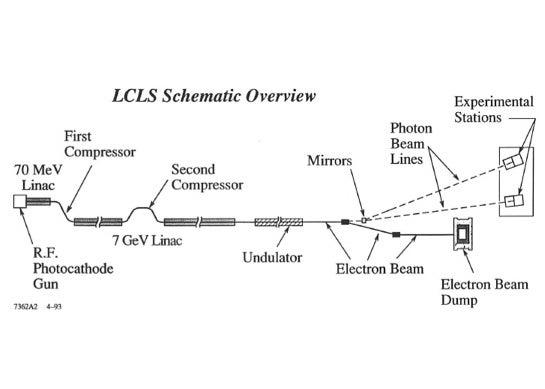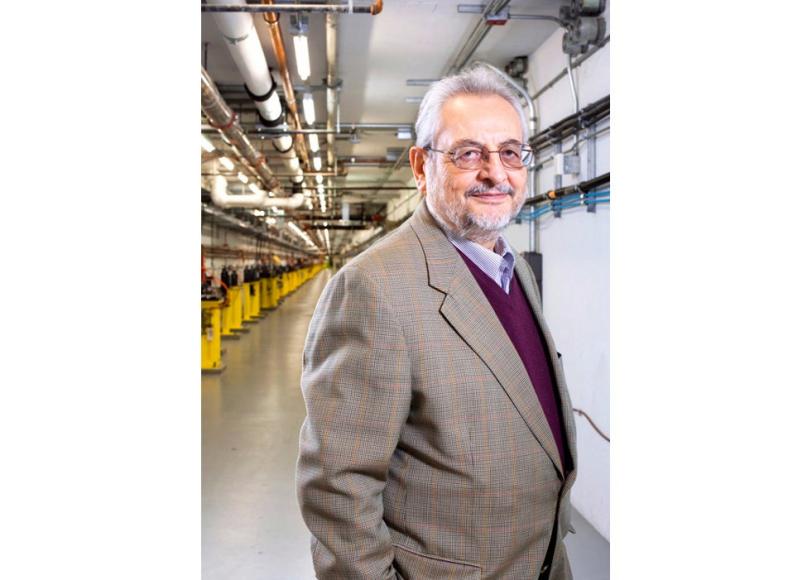20th Anniversary of a Great Idea: Building the LCLS at SLAC
The spectacular success of the Linac Coherent Light Source (LCLS), the world’s first hard X-ray free-electron laser, has put SLAC National Accelerator Laboratory at the frontier of photon science.
By Herman Winick
The spectacular success of the Linac Coherent Light Source (LCLS), the world’s first hard X-ray free-electron laser, has put SLAC National Accelerator Laboratory at the frontier of photon science. Although relevant work was done by many scientists 30 or more years ago, the idea for the LCLS at SLAC really got started 20 years ago this month, when 146 scientists from around the world gathered here in 1992 – from Feb. 24 to Feb. 27 – for the Workshop on Fourth Generation Light Sources.
At this workshop Claudio Pellegrini of the University of California-Los Angeles stood up to propose that a powerful new free-electron laser, operating in the previously unattainable short X-ray wavelength range of 4 nanometers to 0.1 nanometers, could produce an astonishing 10 gigawatts of peak power, and that it could be built at relatively low cost by making use of part of SLAC's 2-mile-long linear accelerator.
Such a source would greatly enhance the opportunities for research in this wavelength range, which includes the "water window" – wavelengths particularly suitable for studying carbon-containing materials such as human cells. It thus had the potential to revolutionize the science under way at dozens of storage ring-based light sources around the world, including SPEAR at SLAC.
In the conclusion of his paper, "A 4 to 0.1 nm FEL Based on the SLAC Linac,:" Claudio wrote:
We have shown that using existing electron gun technology and the SLAC linac one can build today a FEL in the water window, at about 4 nm. An improvement in the gun emittance by a factor of three for the same longitudinal brilliance, would allow the extension of the system to 0.1 nm. In both cases the radiation brightness far exceeds any other source existing or under construction, and would open a completely new region of experimentation.
Claudio pointed to developments in three areas of accelerator technology that enabled his proposal:
1. High-brightness electron sources: In the 1980s a group at Los Alamos National Laboratory showed that so-called radiofrequency (rf) photocathode guns, which shine ordinary laser light onto a copper cathode to generate electrons, could produce very high-brightness electron beams. An advanced version of this type of gun now provides the electrons for LCLS.
2. Preserving electron beam brightness during acceleration, transport and compression: To achieve collisions in the SLAC Linear Collider (SLC) project in the late 1980s, bright electron and positron beams from the SLAC damping rings had to be accelerated to 50 billion electronvolts (GeV), compressed and transported to the interaction point while preserving their initial brightness. To accomplish this, SLAC developed much relevant instrumentation (diagnostics, controls, feedback systems, etc.). Claudio pointed out that the success of SLC gave confidence that this could also be done for an even brighter electron beam from an rf photocathode gun at the LCLS.
3. Undulator technology: Undulators are arrays of magnets that are used to bend the paths of electrons back and forth. This causes the electrons to emit X-ray light for use in research. The first permanent-magnet undulator, a 2-meter-long device conceived by Klaus Halbach at Lawrence Berkeley National Laboratory, had been tested in SLAC's SPEAR storage ring in 1979. Since then, longer undulators built with the higher precision required for the LCLS had been developed at SLAC and many other synchrotron radiation labs around the world. The LCLS now uses up to 108 meters of undulator magnets.
Even before his 1992 presentation, Claudio and others had done much theoretical work on using linacs and storage rings as drivers for X-ray free electron lasers. But his suggestion that it would be possible to modify and use part of the SLAC linac to achieve this, at significantly lower cost than building a new linac, galvanized me and others to join with Claudio to begin to study this in detail.
In a series of monthly meetings, starting less than four weeks after the Fourth Generation Workshop, a group of about 20 scientists began a study leading to the first proposal for a modest 4-nanometer FEL. Most were accelerator physicists, from SLAC, UCLA, Europe’s CERN particle physics laboratory, Germany's DESY lab and Lawrence Berkeley, Lawrence Livermore, Argonne and Brookhaven national labs.
A remarkable feature of these meetings was that all the participants had major responsibilities in their regular day jobs. I merely sent out an email announcing the topics to be discussed at the next meeting and they came, often from a great distance, out of interest and eagerness to contribute their special skills and experience to what we all perceived to be an exciting venture. Not only did they come to the monthly meetings, but many also presented the work they had done between meetings.
At SLAC, their participation in the early and mid 1990s was tacitly approved, and even encouraged, by Burt Richter, then director of SLAC, and Arthur Bienenstock, then director of the Stanford Synchrotron Radiation Lightsource. Later in the 1990s, SLAC Director Jonathan Dorfan and SSRL Director Keith Hodgson continued this support. Apparently, the bosses of scientists from other labs also encouraged their participation.
Claudio, who is now at SLAC, was the driving figure in these meetings, engaging specialists in all the relevant areas and pointing out where more detailed study and experimental R&D was needed. By November 1992, work done at these meetings led to an outside review of a preliminary proposal for a 4-nanometer FEL at SLAC.
This first proposal called for equipping the last part of the SLAC linac with a new rf photocathode gun, compressing and accelerating the electron beam to about 7 GeV, putting this beam through a 34-meter-long undulator located in an existing shielded enclosure then in use for the SLAC Final Focus Test Beam, and deflecting the X-ray beam emerging from this undulator into an experiment station in a modified existing building in the SLAC research yard.
The spent electron beam would be deflected into a beam dump (see figure). The photon beam would operate at 120 Hz and produce a remarkable 10 gigawatts of peak power. Using existing equipment and structures would bring the total cost for this project down to about $30 million.
There is much more to the story of how this modest initial proposal morphed into the final proposal for the LCLS, now producing pulses as short as 10 femtoseconds (one femtosecond is one millionth of one billionth of one second) at wavelengths down to about 0.1 nm, and how a strong scientific case was developed, leading to Department of Energy funding of about $400 million for the project. But I am told to keep this note short.
Stay tuned for the next installments of the LCLS story about the extension of research capability (pushing peak power to the hundreds of gigawatt or even terawatt level), increase in capacity to serve more users, and the LCLS-II project now under way.


(Photo by Michelle McCarron)